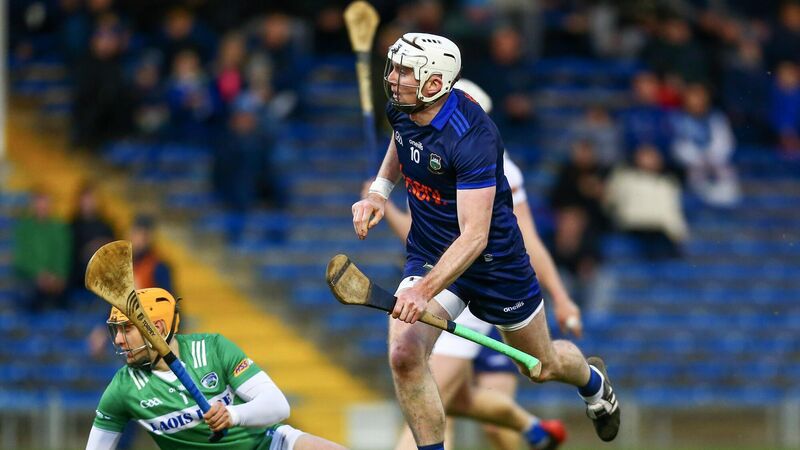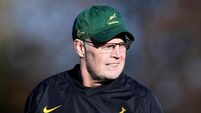Enda McEvoy: Under Liam Cahill, Tipp will be aiming high and shooting low

GOAL GLUT: Tipperary's Seamus Kennedy watches his shot hit the back of the net against Laois. Pic: INPHO/Ken Sutton
Odd one last weekend. Tipperary only scored two goals.
Very odd, given their provenance - however recent - as inmates of the Liam Cahill stable. By rights we were entitled to expect at least 15 goals.
But they supplemented the two goals they managed with 32 points. And it was the opening night of the league. And they did what they had to do, and comfortably more, in order to see off Laois. And hurling does not offer bonus points for registering monster totals.
Still, given Cahill’s previous when it comes to taking a team and turning it into a precision-tooled goalscoring machine, chances are we’ll see green flags become a staple of the Premier diet over the next couple of months.
Remember his second year with the county’s U21s/U20s? They took Cork for five goals in the All-Ireland final, four of them in the opening eight (!) minutes, the first after 19 seconds.
In the semi-final against Wexford they’d scored eight goals. . Remember Waterford last season? Four goals against Cork in the National League final after putting five past Wexford in the semi-final. No opting for the handy point when the door was ajar. Keep going, brace for the hit, break the tackle, pull the trigger.
Two of the goals in the league decider came from players (Neil Montgomery and Carthach Daly) driving forward from midfield and picking out the man in support. A third came because when Mikey Kiely held up a delivery from deep, Patrick Curran, the only man in support, peeled off his marker and, rather than taking the módh direach, crossed the field to make his run on Kiely’s far side and take the offload.
Just imagine how often those moves had been rehearsed in training and how often they’d broken down before second nature was accomplished. Cahill’s troops racked up 22 goals in the course of winning the competition. Speed, channelled properly, never does anything other than kill.
(To the inevitable charge that keeping the foot on the pedal in springtime finished the Déise for the season, the response is two-fold. Waterford can never win enough national trophies – that’s surely a no-brainer - and in any case enough emerged afterwards to indicate that the real damage in training was an overload in the week prior to Cork’s championship visit to Walsh Park.)
At what stage on his coaching journey Cahill had his eureka moment remains unknown to the uninitiated. One can see his thinking nevertheless. In an era where even heavily beaten teams in the championship surpass 20 points, why not set yourself apart from the mob by aiming for three goals per outing? An instant nine-point cushion and a large hill, if not a mountain, for the other crowd to climb.
It may be catching on. Pat Ryan has spoken of Cork’s need to score “three or four goals” a game. No harm in aiming high and shooting low. If no team are capable of outpointing Limerick, goals offer a feasible alternative.
Not that the dimensions of the challenge facing Cahill bear underestimating should he be determined to turn Tipp, the supreme exponents of the point from distance these past ten years, into a goalscoring entity.
He achieved it with U20s but, well, they were U20s. He achieved it with Waterford but that was in springtime, when they were faster and fitter and hungrier and snappier than everyone else. High summer elides disparities in speed and upper body strength and the harmony of the collective.
On Sunday Cahill heads to Nowlan Park and we’ll be a bit wiser afterwards.
It is superfluous to point out that the fixture is not what it was or that Limerick/Clare is the biggie this weekend. Times change. Legends retire. Rivalries lose their heat. Age withers. Only Noel McGrath remains unaffected. Him and that portrait in his attic.
Right, a quick party game. Gearóid O’Connor, Cian O’Dwyer, John Campion and Sean Ryan lined out for their county last weekend. Gearóid Dunne, Paul Cody, Niall Rowe and Shane Murphy lined out for their county too. Which players and which county?
If you knew or reckoned the first four played for Tipp and the second four played for Kilkenny, good for you. If you had it the other way around, relax. Nobody’s laughing at you. Changed times, remember.
The similarities between the two managers are obvious. Success at U20 level. Now stepping up to the big one.
The dissimilarities are obvious too. Cahill was a brilliant minor and an All-Star as a teenager; Derek Lyng didn’t wear a county jersey at any level till he was 20. Cahill was 23 and his best days were behind him when he picked up his All-Ireland medal as a sub; Lyng didn’t win his first All-Ireland medal till the same age, upon which he didn’t stop winning them.
But another similarity. They’ve both had plenty of time to think about the game, in Lyng’s case before he made Broadway and in Cahill’s case after it. In neither instance has the time been wasted.
In the short term Lyng’s job is the more difficult, and not merely because of the boots he’s filling and the Ferguson/Moyes comparison. Oh no. The task is much bigger than that. It is incumbent on him to rethink Kilkenny’s game, to rewrite the manual, to embrace not a tactical shift but a strategic – nay, an entire doctrinal – leap. Nothing less.
On which point, your correspondent has long argued that twice a decade every county should convene a meeting of the tribal elders, the great and the good, the young and the promising, and get stuck into a bout of what the marketing folk like to describe as blue-sky thinking.
What kind of hurling should we be aspiring to at intercounty level? What kind of hurling are we producing? If there is a gap, how is it to be bridged?
Lyng’s Kilkenny are unlikely to be pretty to watch any time soon. The sliotar will be sprayed wide. It’ll be recycled backwards. It’ll be smuggled sideways. Repeat and rinse till the gap is carved and the incision made. Every ball does not have to go forward.
Short-term boredom or frustration may be unavoidable. But trust the process.
In any case Lyng is conscious of hurling’s journey since his playing days. Possession is for cherishing, not for squandering. Not unless you have the Wexford forward line of the 1950s as your outlet.
He knows too that the sliotar doesn’t have to descend from the heavens on TJ or Walter every time. In fact it should only descend on them at widely spaced intervals.
Lyng’s triumphant U20s were no clones of Cahill’s. In their four outings en route to All-Ireland glory last season, plus one helping of extra time, they managed five goals. They won three of the matches by a point, the final included.
They weren’t spectacular, then, and they weren’t packed with superstars. But they were well coached and they had spirit by the bucketload and that’s no bad starting point.
Moreover the best of them have time on their side whereas the clock is ticking for some of the members of Cahill’s 2018-19 cohort.
If any man can turn the key for them it’s him. And if along the way he helps bring goals back into fashion he’ll have rendered the state, never mind the county, quite the service.








